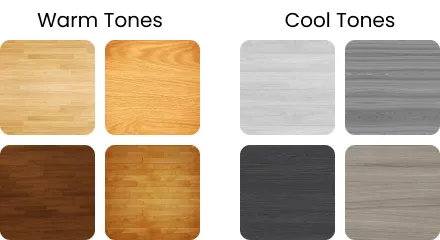The rule of opposite
When selecting a color palette for a room, many people focus solely on the walls and ceiling, overlooking the effect that flooring material and color have on the overall aesthetic. However, the flooring is just as important and contributes to the overall look and feel of the space.
A general rule is to paint the walls in color opposite to the undertone of your floors. See below for examples of floor with warm and cool undertones. An undertone is a color that influences the overall hue. It’s clearly visible when a painted surface is illuminated by neutral white light. Warm undertones create a red, yellow, or orange effect, while cool undertones create a blue, purple, or grey look.
Examples

Below is an example of the correctly chosen dark wall color chosen to match with light floor color. The floor here looks yellowish, hence, it has a warm undertone. So the shades of blue/green/violet which are cool colors will work well. Avoid warm wall colors like red/orange/yellow in this case.

While the rule stated above doesn’t depend on whether a hardwood, tile, carpet, and laminate flooring is selected, the availability of certain colors in different types dictates the options for the matching wall color. For example, most laminate floors have warm and yellow undertones. Most carpets have slightly darker undertone.
Therefore, the flooring material and color can either complement or clash with the walls and ceiling, affecting the visual balance of the room. Moreover, different flooring materials have different reflective properties, which can impact the way that colors appear in space. For example, a brightly colored shag carpet may clash with a dark and moody color palette, making the room feel overwhelming and unattractive. On the other hand, a neutral-colored hardwood floor can provide a versatile backdrop for a variety of color palettes, allowing homeowners to experiment with different hues and shades.
While following the rule of contrast generates good options for you, sometimes breaking the rule and choosing a light color flooring with lighter paint color options works as well as long as the colors don’t clash. Therefore, no choice of color is good or bad in absolute but the final decision rests on you.
To help you make that decision, confidently we have created an AI-powered color consultant takes into account all these factors to help homeowners select the right color palette for their space, providing them with confidence in their final choice. We have a comprehensive approach that considers both the flooring material and color as well as the walls, ceiling, and lighting conditions when selecting a color palette for a room. This would ensure that the final result is a harmonious and well-balanced space.





